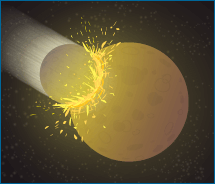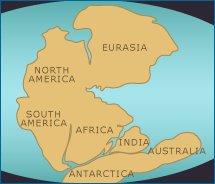Scientific arguments work the same way — whether we are interested in an ongoing phenomenon (say, gravity) or ancient history (say, the origin of life). It might at first seem strange to generate expectations about something that happened long ago, but in fact, it's no different than generating expectations based on any other hypothesis or theory. The key is to remember that we are figuring out what we would expect to observe today, if a particular event had happened in the past.
These examples illustrate how scientific ideas about past events can generate testable expectations:
- Idea: The moon chipped off the old block — that is, the moon formed from debris flung up by early Earth when it was struck by another large body. This proposed event would have happened some 4.5 billion years ago; nevertheless, a little reasoning and some background knowledge easily lets us generate expectations to test this idea. For example, if the chip-off-the-old block theory were true, the moon should have a similar composition to that of the Earth's crust 4.5 billion years ago. Well-established ideas in geology and planetary science suggest that, by that time, iron and heavy elements in Earth's crust would have already sunk to its core. So we would expect the moon to be deficient in iron like the Earth's crust, and in fact, recent Apollo missions have borne out this expectation. Moon rocks are low in iron, which lends support to the chip-off-the-old-block theory.
- Idea: It was an RNA world — that is, RNA arose several billion years ago as the first self-replicating molecule and formed the basis of heredity and metabolism in the ancestor of all life on Earth. What expectations can we generate about such ancient chemical reactions? Well, if the idea were accurate, then we would expect to be able to recreate some of the key chemical reactions leading up to replicating RNA. After all, if a particular chemical reaction actually happened on early Earth, then we should be able to produce a similar reaction in a lab situation that simulates conditions on early Earth. Has this expectation been borne out and thus, lent support to the theory? To some extent, but science is a work in progress. Many plausible chemical reactions in this sequence have been discovered, but there are still gaps in our knowledge, which are being filled as chemists continue to work on this knotty problem.
- Idea: Once, there were no borders — that is, some 250 million years ago, all the continents we know today were joined together like a jigsaw puzzle. How can we know where the continents used to be? Well, from the clues they left behind, of course. If the continents had been joined together, then the ancient animals that lived on them should have roamed freely across what are now continental coastlines. Thus, where fossilization was likely, we would expect to find corresponding fossils on the coasts of now distant continents. And in fact we do observe this. For example, fossils of the extinct reptile Cynognathus dating to around 240 million years ago have been found in both South Africa and South America, lending support to the no-borders idea.



Here we've examined just one expectation (and one line of evidence) generated by each of three scientific ideas, but of course, in reality, each of these ideas generates multiple expectations …